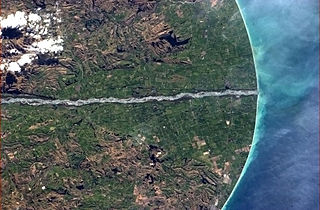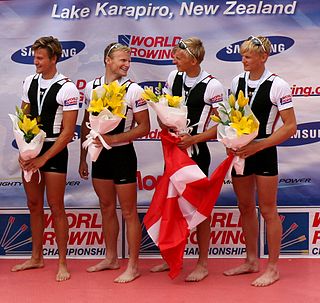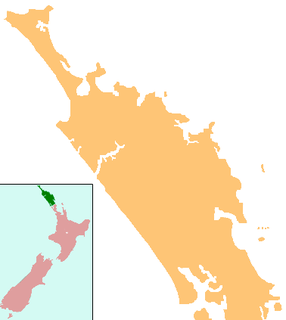
Zealand or Sealand, at 7,031 km2, is the largest and most populous island in Denmark proper. Zealand has a population of 2,319,705.

The South Island, also officially named Te Waipounamu, is the larger of the two major islands of New Zealand in surface area, the other being the smaller but more populous North Island. It is bordered to the north by Cook Strait, to the west by the Tasman Sea, and to the south and east by the Pacific Ocean. The South Island covers 150,437 square kilometres (58,084 sq mi), making it the world's 12th-largest island. At low altitude, it has an oceanic climate.

Lake Taupo, often spelled Taupō, is a lake in the North Island of New Zealand. It is in the caldera of the Taupo Volcano. The lake is the namesake of the town of Taupō, which sits on a bay in the lake's north-eastern shore. With a surface area of 616 square kilometres (238 sq mi), it is the largest lake by surface area in New Zealand, and the second largest freshwater lake by surface area in geopolitical Oceania after Lake Murray in Papua New Guinea. Motutaiko Island lies in the south east area of the lake.

Queenstown is a resort town in Otago in the south-west of New Zealand's South Island. It has an urban population of 16,000.

Taupō, sometimes spelled Taupo, is a town on the north-eastern shore of Lake Taupo in the central North Island of New Zealand. The town is the largest urban area and the seat of the Taupo District, and the second-largest urban area in the Waikato region behind Hamilton.

The Waikato River is the longest river in New Zealand, running for 425 kilometres (264 mi) through the North Island. It rises in the eastern slopes of Mount Ruapehu, joining the Tongariro River system and flowing through Lake Taupo, New Zealand's largest lake. It then drains Taupo at the lake's northeastern edge, creates the Huka Falls, and flows northwest through the Waikato Plains. It empties into the Tasman Sea south of Auckland, at Port Waikato. It gives its name to the Waikato region that surrounds the Waikato Plains. The present course of the river was largely formed about 17,000 years ago. Contributing factors were climate warming, forest being reestablished in the river headwaters and the deepening, rather than widening, of the existing river channel. The channel was gradually eroded as far up river as Piarere, leaving the old Hinuera channel through the Hinuera Gap high and dry. The remains of the old river path can be clearly seen at Hinuera where the cliffs mark the ancient river edges. The river's main tributary is the Waipa River, which has its confluence with the Waikato at Ngāruawāhia.
Cambridge is a town in the Waipa District of the Waikato region of the North Island of New Zealand. Situated 24 kilometres (15 mi) southeast of Hamilton, on the banks of the Waikato River, Cambridge is known as "The Town of Trees & Champions". The town has a population of 20,500, making it the largest town in the Waipa District, and the third largest urban area in the Waikato.

Rotorua is a city on the southern shores of Lake Rotorua from which the city takes its name, in the Bay of Plenty region of New Zealand's North Island. It is the seat of the Rotorua Lakes District, a territorial authority encompassing Rotorua and several other nearby towns. Rotorua has an estimated resident population of 58,500, making it the country's 12th largest urban area, and the Bay of Plenty's second largest urban area behind Tauranga.

The Waitaki River is a large braided river that drains the Mackenzie Basin and runs some 209 kilometres (130 mi) south-east to enter the Pacific Ocean between Timaru and Oamaru on the east coast of the South Island of New Zealand. It starts at the confluence of the Ōhau River and the Tekapo River, now in the head of the artificial Lake Benmore, these rivers being fed by three large glacial lakes, Pukaki, Tekapo, and Ōhau at the base of the Southern Alps. The Waitaki flows through Lake Benmore, Lake Aviemore and Lake Waitaki, these lakes being contained by hydroelectric dams, Benmore Dam, Aviemore Dam and Waitaki Dam. The Waitaki has several tributaries, notably the Ahuriri River and the Hakataramea River. It passes Kurow and Glenavy before entering the Pacific Ocean. The River lends its name the Waitaki District on the south side of the river bank.

Lake Karapiro is an artificial reservoir lake on the Waikato River at Karapiro, 8 kilometres (5.0 mi) south-east of Cambridge in New Zealand's North Island. The lake was formed in 1947 by the damming of the Waikato River to store water for the 96-megawatt Karapiro power station. The lake is also one of two premier rowing venues in New Zealand and is the base for the country's high-performance rowing programme.

Vincent Keoni Manuwai was an American football guard. He was drafted in the third round of the 2003 NFL Draft by the Jacksonville Jaguars. He played college football for the University of Hawaii Warriors.

There are 3,820 lakes in New Zealand that have a surface area larger than one hectare. Many of the lakes in the central North Island are volcanic crater lakes. The majority of the lakes near the Southern Alps were carved by glaciers. Artificial lakes created as hydroelectric reservoirs are common in South Canterbury, Central Otago and along the Waikato River.
Far North District Council is the territorial authority for the Far North District of New Zealand.

The 2010 World Rowing Championships were World Rowing Championships that were held from 31 October to 7 November 2010 on Lake Karapiro near Cambridge, New Zealand. The annual week-long rowing regatta was organised by FISA. Usually held at the end of the northern hemisphere summer, they were held later in the year in the southern hemisphere. In non-Olympic years the regatta is the highlight of the international rowing calendar.

Lake Waingaro is a lake in the Northland Region of New Zealand. The lake is a main supply of water for the Kerikeri Town Water Supply.

Caesar Roose (1886–1967) was a New Zealand ship owner and operator, flax and timber miller, businessman, entrepreneur, community leader and philanthropist. He was born in Mercer, Waikato, New Zealand in 1886.

Wairere Boulders is a privately-owned nature reserve and tourist attraction at Horeke in the south Hokianga region of Northland, New Zealand. The property contains geologically rare rock formations. Visitors to the property can walk around the various trails, kayak down the boulder river and stay at the campsite.

Kapiro is a locality in the Far North District of Northland, New Zealand. State Highway 10 passes through Kapiro. Waipapa is 2.7 km south, and Kaeo is 19 km northwest, by road.















